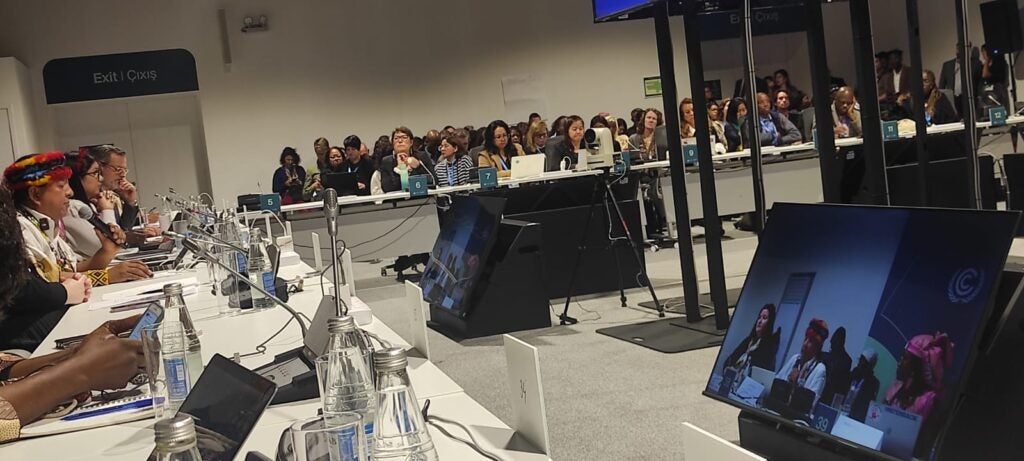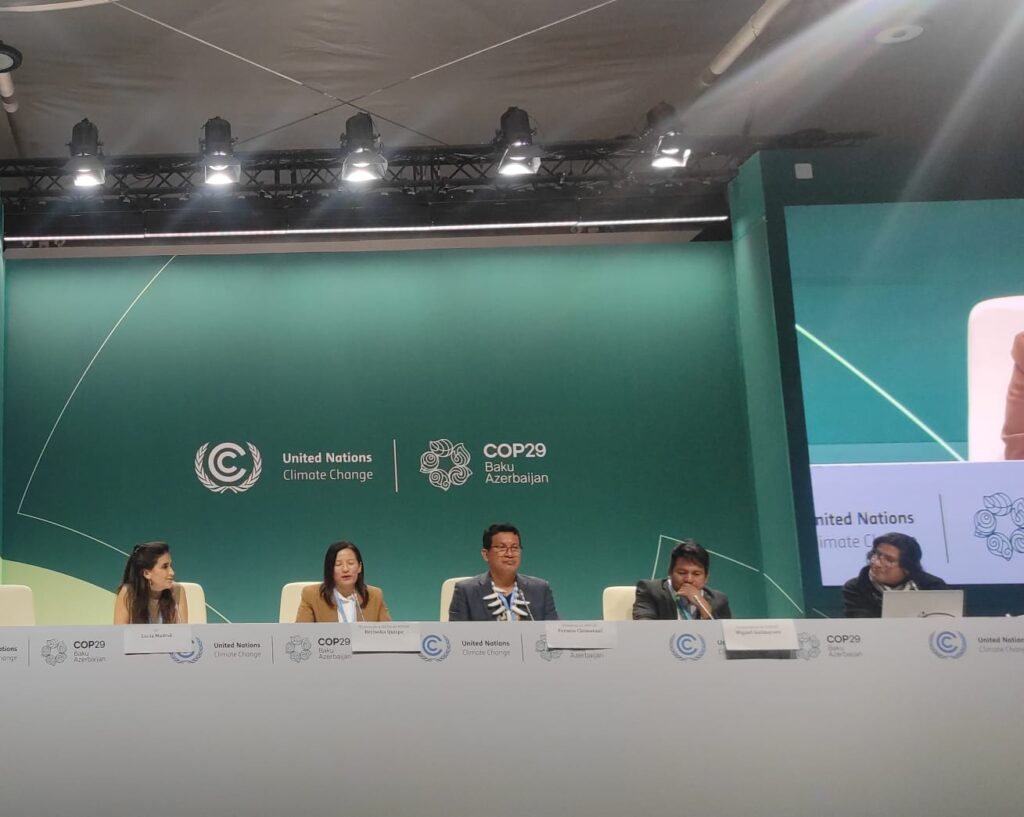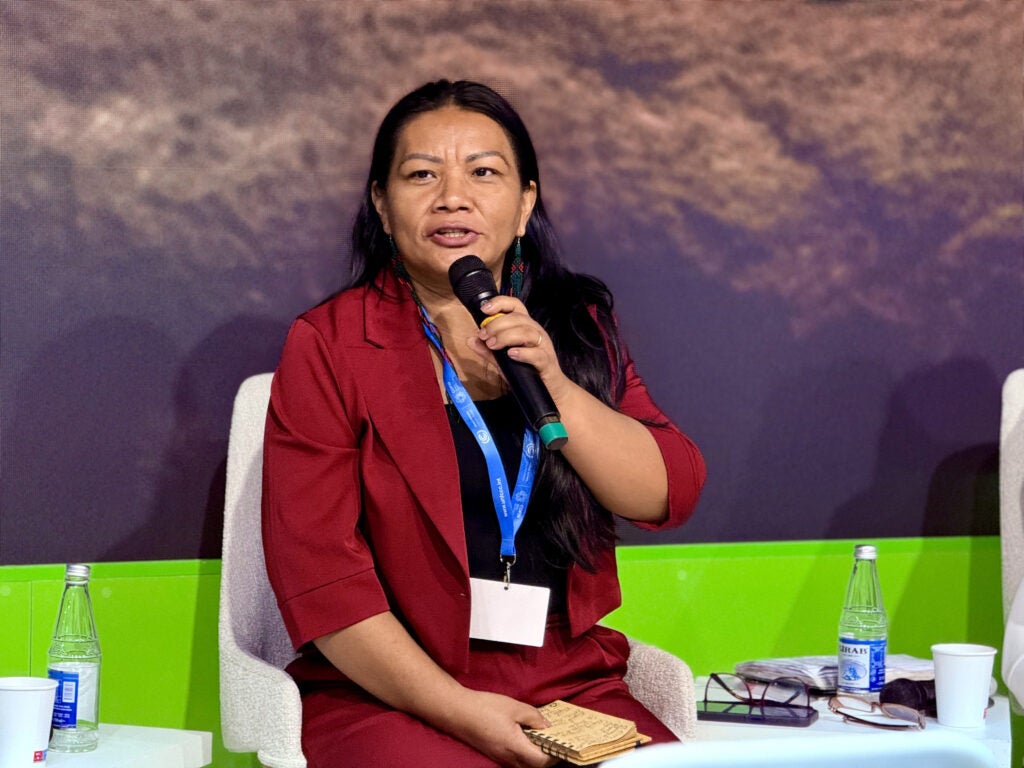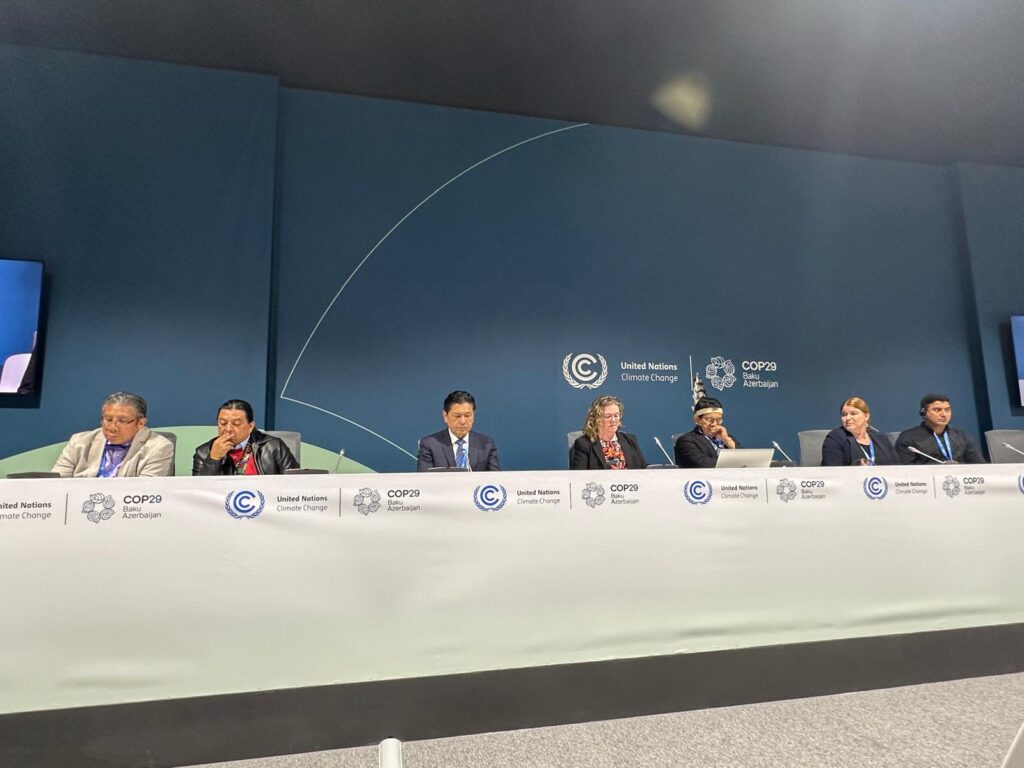
Juan Carlos Jintiach from the Global Alliance of Territorial Communities, speaking on direct access to finanance for Indigenous People at COP29. Photo by Bärbel Henneberger.
This post was authored by Bärbel Henneberger, Senior Partnerships Manager at the Environmental Defense Fund.
On November 21, COP29 celebrated Indigenous Peoples and Local Communities (IP and LCs) as a thematic day in the Action Agenda of the Azerbaijani COP presidency. The day underscored the essential role of IP and LCs in safeguarding 80% of the world’s biodiversity and preserving 36% of intact forest landscapes.
To succeed in the fight against climate change, we must collaborate with IPs and LCs and respect their principles, culture, and methods while providing the support they need to further our shared conservation goals. We won’t succeed in conserving tropical forests without the partnership and leadership of IPs and LCs.
Climate conferences like COP29 offer a platform for IP and LCs to amplify their voices, and shape negotiations. It’s an opportunity for them to show the world how their efforts to conserve and sustainably manage their territories, which are some of Earth’s most important ecosystems, are critically important in the climate fight.
At COP29, IP and LC delegates spotlighted examples of effective participation in negotiations, policy frameworks, and innovative climate finance mechanisms. These efforts, though diverse, share a common goal: to embed Indigenous rights and knowledge systems into global climate action. Below are a few examples of Indigenous approaches to conservation efforts showcased during COP29. Critically, the world must continue to support, and learn from, these approaches well after the negotiations in Baku have ended.
Spotlight on LCIPP and the IP Caucus
Onel Masardule, of the Kuna People of Panama and representative for the Local Communities and Indigenous Peoples Platform (LCIPP), shared insights into the Platform’s Facilitative Working Group, which launched its 2024–2027 work program in Baku. Key priorities include youth empowerment, improved communication channels to reach diverse communities, and the establishment of a Global Indigenous Youth Forum.
Onel emphasized that such initiatives recognize the unique position of Indigenous youth as both inheritors of traditional knowledge and active participants in shaping climate futures. Programs like these ensure that the next generation is equipped to address climate challenges while staying rooted in ancestral wisdom.
Article 6.4
In negotiations on Article 6.4 of the Paris Agreement, Indigenous leaders pushed for safeguards that go beyond recognition to meaningful integration of rights and participation of Indigenous Peoples.
Johnson Cerda, member of the Kichwa People from the Ecuadorian Amazon, and member of the Indigenous Peoples Caucus thematic working groups, shared concerns raised by Indigenous representatives including on the recognition of Indigenous rights in Article 6.4. The safeguards in Article 6.4 acknowledge Indigenous rights under national legislation. However, most countries don’t legally recognize these rights, and many have not adopted international instruments like the UN Declaration on the Rights of Indigenous Peoples (UNDRIP). This complicates implementation of these safeguards.
Conversely, positive steps, such as acknowledging ancestral land rights without requiring formal titles, signal potential pathways for greater IP and LC involvement in carbon projects.
Innovative Climate Finance: Indigenous Jurisdictional REDD+
One of the standout moments at COP29 was the presentation of the Indigenous Jurisdictional REDD+ initiative from Peru. The Architecture for REDD+ Transactions (ART) recently published the concept note for the initiative. Led by Peruvian Indigenous organizations AIDESEP, ANECAP and CONAP, this approach emphasizes High Forest, Low Deforestation (HFLD) areas—regions with historically low deforestation where the world’s few remaining intact forests are found. HFLD regions are facing increasing deforestation pressures. By aligning REDD+ carbon crediting mechanisms with Indigenous territorial frameworks, the Indigenous Jurisdictional REDD+ initiative underscores the need for localized, culturally attuned solutions to deforestation and climate change.

Peru Group of Indigenous People presenting their Jurisdictional Indigenous Redd+ approach at COP29. Photo by Bärbel Henneberger
During several events of the Brazilian Amazon States Consortium, the Acre State Secretariat for Indigenous Peoples highlighted the Acre Jurisdictional REDD+ Program. Secretary Francisca Arara highlighted the collaboration between the Secretariat and EDF to address climate change and Indigenous issues in Acre, Brazil. EDF has supported the Secretariat in restructuring policies, advocating for Indigenous rights, and participating in global forums like COP29 and New York Climate Week. The focus of the Secretariat is on implementing sustainable public policies, securing international resources, and addressing challenges such as droughts, floods, and health crises in indigenous territories, topics Francisca is highly concerned about.
The Secretariat underscored the importance of bolstering partnerships to meet these escalating challenges while ensuring the rights and resilience of Indigenous communities and preparing for Brazil’s hosting of COP30.

Francisca Arara, Acre State Secretary for Indigenous Peoples, during a side event panel at COP29 in Baku. Photo by Pedro Devani.
Beyond Carbon: The TREES Co-Benefits Certification
A pivotal innovation introduced at COP29 is the ART-TREES co-benefits certification. Jointly developed with IP and LC organizations from Mexico, Peru, Congo Basin and Brazil, the TREES co-benefits certification recognizes the holistic value Indigenous stewardship brings to conservation, including the social and cultural benefits of REDD+ initiatives. EDF has supported this process for the last two years. The new co-benefits certification scheme captures the value of jurisdictional REDD+ beyond carbon, including social and cultural benefits of REDD+ initiatives.
Set to open for public comment in December, this certification reflects the growing acknowledgment that climate solutions must integrate environmental, social, and cultural dimensions to be truly sustainable.

Socio-cultural committee presenting the co-benefits certification under ART during a Side Event at Cop29, in Baku. EDF participated in this event, and has supported the process. Photo by Gloria Díez.
Challenges and the Road Ahead
While IP and LC engagement at COP29 is laudable, challenges remain. Funding gaps persist, limiting the implementation of large-scale forest conservation projects in Indigenous territories. Moreover, carbon activities under Article 6.4 mechanisms need stronger guarantees of free, prior, and informed consent (FPIC) and the recognition of Indigenous systems for conflict resolution.
The need for robust governance structures, equitable resource distribution, and capacity-building initiatives is clear. These measures are vital not only for ensuring Indigenous participation but also for leveraging their invaluable contributions to climate resilience.
Conclusion
The increased visibility and participation of Indigenous Peoples at COP29 in the multilateral climate spaces is something to carry forward for years to come. By centering their rights, knowledge, and leadership, the international community gains access to time-tested strategies for the conservation of nature.
Supporting Indigenous-led initiatives, scaling sustainable finance, and ensuring equitable representation are not just ethical imperatives but strategic necessities in the fight against climate change.









